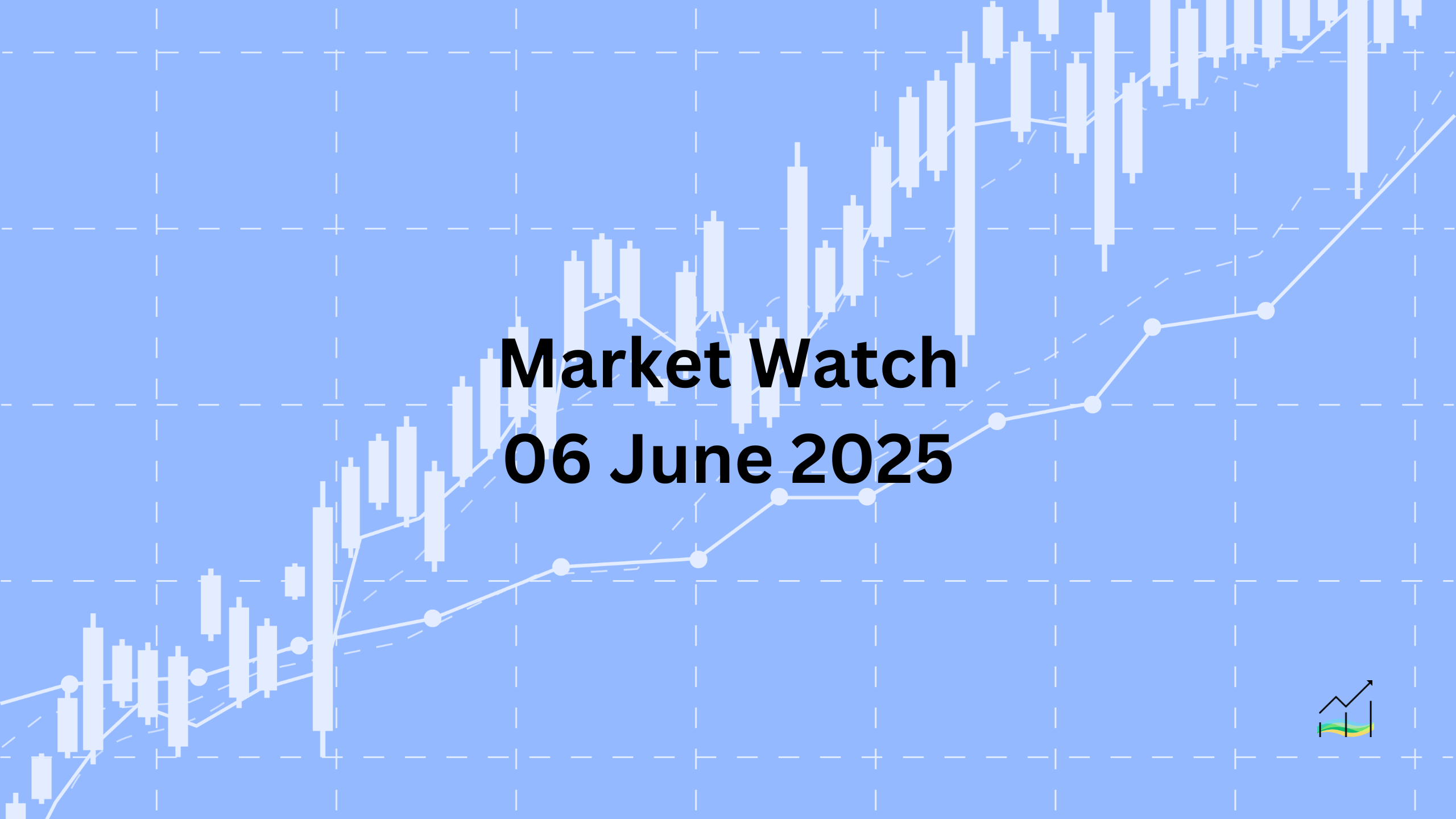06/06/2025 Market Watch

Markets Cautious Ahead of U.S. Jobs Data Amid Global Economic Softness
Key Takeaways:
- US-China leaders held their first call since inauguration, with unclear outcomes.
- Mixed economic messages from US labour data and weak industrial reports globally.
- Dollar remains firm against G10 currencies but mixed vs emerging markets.
- Bond yields eased amid poor data from Japan and Germany.
- Gold and oil are trading in tight ranges as markets await further cues.
Markets are entering the week with caution as investors await the latest US employment data, a key report following a string of recent disappointments. While the dollar remains firm against most major currencies, it is showing mixed performance against emerging markets, particularly due to the euro’s decline affecting Central and Eastern Europe. The equity landscape reflects uncertainty, with Asia-Pacific markets ending mixed and Europe's benchmark index struggling to extend its gains. US equity futures are slightly higher, suggesting some optimism after Thursday’s losses.
In geopolitics, the first conversation between US and Chinese leaders since the new term began offered little clarity. The US noted progress on trade, particularly around rare earths, while China voiced concern over arms sales to Taiwan. Although further dialogue has been planned, no timeline has been confirmed. Meanwhile, global bond markets are responding to weak data. Japan’s soft household spending weighed on its yields, and disappointing figures from Germany’s industrial and export sectors pressured European bond markets. US Treasury yields are modestly lower, with the 10-year yield approaching 4.37%, performing better than most global counterparts. Commodity markets remain subdued, with gold consolidating within a narrow range and oil prices holding near recent highs.
United States of America
Overview
The US dollar is attempting to recover after a sharp decline brought the Dollar Index to its lowest level since April. The initial weakness followed comments from the ECB that confirmed expectations of a near end to its rate-cutting cycle. However, renewed optimism after a call between US and Chinese leaders helped stabilise sentiment and lift the dollar modestly. Market focus has now shifted entirely to the upcoming US employment report, especially after a series of mixed signals on the health of the labour market.
Expectations point to a slowdown in job growth for May, with attention firmly on any potential uptick in the unemployment rate. Recent data has painted a contradictory picture: the JOLTS report showed rising job openings, while the ADP private sector figure came in far below expectations. The market may react more strongly to changes in the unemployment rate than to the headline payroll figure. Broader economic concerns include signs of consumer stress, as seen in the sharp decline in consumer credit growth in Q1. While April’s figures are due today, they are unlikely to move markets.
Economic Drivers
- Markets reacted initially to ECB commentary, which confirmed that the rate-cut cycle in Europe is nearing its end.
- A phone call between US and Chinese leaders helped ease geopolitical concerns, supporting the dollar.
- The labour market continues to cool, with average monthly job growth slowing compared to last year.
- The private sector showed mixed employment signals, with growth in job openings but weakness in ADP hiring.
- Consumer credit growth has slowed, reflecting increasing debt pressure and potential spending restraint.
Data and Events
- 06 June 2025: Average Hourly Earnings.
- 06 June 2025: Non-Farm Employment Change.
- 06 June 2025: Unemployment Rate.
Price Action
- Dollar Index rebounded from 98.35 to test the 99.00 level.
- Resistance seen near 99.40; a break above could improve sentiment.
- Short-term direction remains tied to labour market data and Fed rate cut expectations.
Key Points:
- Dollar stabilised after US-China call and ahead of jobs data.
- May job growth expected to slow; market focus is on unemployment rate.
- Mixed labour signals: strong JOLTS vs weak ADP.
- Consumer credit growth sharply declined in Q1.
- Market sensitive to data surprises that may shift Fed expectations.
Canada
Overview
The Canadian dollar reached its highest level this year before pulling back, following the release of troubling trade data. A sharp 16% drop in exports to the US drove Canada’s goods trade deficit to a record level, sparking volatility in the currency. After briefly strengthening to CAD1.3635, the greenback regained ground and hovered near CAD1.3685, with further upside capped near the CAD1.3700 area.
Attention now turns to Canada’s labour market, which has slowed noticeably over the past year. The country averaged just 13,000 new jobs per month in the first four months of 2025, a steep decline from the same period in 2024. Notably, full-time employment has contracted this year, in stark contrast to last year’s growth. The unemployment rate has steadily risen over the past 18 months and hit 6.9% in April. If forecasts prove correct, it will cross the 7.0% mark, reflecting broader economic fatigue. These labour concerns follow the Bank of Canada's decision to hold its policy rate at 2.75%, a level considered within the neutral range.
Economic Drivers
- Canada reported a record goods trade deficit due to a 16% collapse in exports to the US.
- Labour market continues to weaken, with sharp drops in full-time employment.
- Job creation has slowed significantly compared to 2024.
- The unemployment rate has been climbing steadily, suggesting a cooling economy.
- The Bank of Canada held its policy rate steady at 2.75%, reflecting a wait-and-see stance.
Data and Events
- 06 June 2025: Employment Change.
- 06 June 2025: Unemployment Rate.
Price Action
- Canadian dollar reached a yearly high near CAD1.3635 before retreating.
- Support seen around CAD1.3685; resistance at CAD1.3700.
- A break above CAD1.3700 could open the path to CAD1.3750.
Key Points:
- Canada posted a record trade deficit after US-bound exports plunged.
- Labour market data expected to show further job losses and rising unemployment.
- Full-time employment has declined consistently in 2025.
- Bank of Canada held rates steady amid growing signs of economic weakness.
- CAD gains faded after brief strength, as focus shifted to labour data.
China
Overview
The offshore yuan continues to trade within a defined range, holding above its recent seven-month low. After rebounding from CNH7.1615 in late May, the dollar strengthened to around CNH7.1870, suggesting a potential new range between CNH7.16 and CNH7.23. The People’s Bank of China (PBOC) has maintained a steady hand on the daily reference rate, signalling controlled flexibility despite wider market volatility.
Market attention is shifting toward China’s May inflation data, due early Monday. The outlook remains tilted toward deflation, with consumer prices expected to post another year-on-year decline. While core inflation remains marginally positive, headline CPI has been under pressure largely due to falling food prices. On the industrial side, producer price deflation appears to be deepening, with expectations pointing to the steepest decline since mid-2023. This reflects lingering weakness in factory pricing despite signs of previous stabilisation. In contrast, China’s bond yields remain relatively elevated compared to deflation-prone economies like Switzerland, indicating ongoing investor caution.
Economic Drivers
- Offshore yuan range stabilising after pressure in late May.
- PBOC maintaining steady reference rates to limit excessive currency volatility.
- Headline CPI expected to remain in negative territory due to declining food prices.
- Core inflation remains positive, but momentum is weak.
- PPI deflation expected to deepen, signalling persistent weakness in factory prices.
- Broader concerns persist around consumer demand, though investment remains strong relative to GDP.
Data and Events
No major economic releases are scheduled today.
Price Action
- Dollar rebounded from CNH7.1615 to CNH7.1870.
- Price action suggests a potential trading range of CNH7.16 to CNH7.23.
- Resistance levels being tested after breaking above CNH7.1820.
Key Points:
- Yuan stabilised as dollar holds above May low.
- China’s inflation data likely to confirm ongoing deflation pressures.
- PBOC reference rates show tight policy control.
- PPI deflation may hit a new cycle low.
- Market remains cautious despite resilient bond yields.
Europe
Overview
The euro saw a sharp rally following the European Central Bank’s decision to lower rates in what markets interpreted as a “hawkish cut,” pushing the currency to nearly 1.1500 before easing. The initial move was supported by improved risk sentiment and rising eurozone rate expectations. However, subsequent developments, including the resumption of US-China talks and weaker German economic data, saw the euro retreat toward 1.1410.
Germany’s latest figures painted a mixed economic picture. While April factory orders rose modestly, both industrial production and exports underperformed expectations. Revisions to March data also lowered previously reported gains, casting doubt on the durability of the recovery. Despite these national-level setbacks, the eurozone economy surprised to the upside in Q1, with GDP growth revised to 0.6% from the initial estimate of 0.3%. This stronger regional performance, coupled with shifting interest rate expectations, continues to anchor euro sentiment.
Economic Drivers
- The ECB delivered a “hawkish cut,” lowering rates while maintaining a firm policy stance.
- Eurozone Q1 GDP was revised higher to 0.6%, double the initial estimate.
- Germany's April industrial production fell more than expected, and exports contracted sharply.
- March’s German data was revised downward, suggesting weaker prior momentum.
- The swaps market responded by pricing in higher eurozone interest rates through year-end.
Data and Events
- 06 June 2025: German & French Industrial Production.
- 06 June 2025: German & French Trade Balance.
- 07 June 2025: ECB President Lagarde Speaks.
Price Action
- Euro climbed to near 1.1500 after ECB announcement, before retreating to 1.1410.
- Support seen near 1.1380; bids re-emerged around 1.1430.
- Sentiment pulled back following US-China developments and weak German data.
Key Points:
- Euro rallied on ECB rate cut interpreted as hawkish.
- Q1 eurozone growth revised sharply higher.
- German data showed broad weakness across production and exports.
- Market expectations for ECB rates shifted higher.
- Euro remains supported, but sensitive to further macro surprises.
Japan
Overview
The yen remains volatile, with the dollar fluctuating between JPY142.40 and JPY144.40 throughout the week. In early European trading today, the dollar advanced toward the upper end of this range, nearing JPY144.20. Despite the intraday strength, a sustained move above JPY144.80 may be needed to confirm a breakout. The recent currency movement reflects both global market uncertainty and local economic concerns.
Japan's latest household spending figures were unexpectedly weak, registering a 0.1% decline for the month instead of the anticipated 1.5% increase. While Q1 2025 saw the strongest year-over-year performance since Q3 2022, the figures still suggest that household consumption remains fragile. In GDP terms, consumer spending showed modest growth in both Q4 2024 and Q1 2025, yet the broader economy contracted by 0.2% quarter-over-quarter in Q1. An updated estimate of this GDP figure is scheduled for release early next week and will be closely watched for signs of underlying momentum.
Economic Drivers
- Household spending unexpectedly fell in the latest monthly report, highlighting weak consumer demand.
- Q1 2025 showed a modest rise in consumer spending despite the overall economic contraction.
- GDP declined by 0.2% quarter-over-quarter in Q1, reflecting broader economic softness.
- The upcoming GDP revision could impact investor sentiment if the contraction is deeper than initially estimated.
Data and Events
- 06 June 2025: Household Spending.
Price Action
- Dollar traded between JPY142.40 and JPY144.40 during the week.
- Current session highs are around JPY144.20.
- A close above JPY144.80 may signal a breakout from the current range.
Key Points:
- Yen remains range-bound amid economic concerns.
- Household spending fell unexpectedly, weighing on confidence.
- Japan's Q1 GDP contracted despite slight gains in consumer activity.
- GDP revision due Monday could shape near-term direction.
- Market remains cautious ahead of key economic updates
United Kingdom
Overview
Sterling climbed to a new three-year high near 1.3615 before easing slightly, showing relative resilience compared to the euro. Bids returned around the 1.3575 level, but the currency retreated again during the European morning to test support near 1.3530. While the broader trend remains constructive, further downside could open up if that support breaks, particularly in light of emerging trade and policy tensions with the United States.
The recent UK-US trade dynamic took a negative turn. Initially, it appeared that UK steel and aluminum would be exempt from new US tariffs, provided the supply chain excluded Chinese-origin materials. However, it was later confirmed that UK metal exports will indeed face the 25% levy recently reintroduced by Washington, linked to the approval of the US Steel-Nippon Steel merger. Additionally, the UK may face further exposure if the final US budget includes Section 899, which targets companies from countries implementing policies that Washington opposes, including digital service taxes or the OECD’s global minimum tax rules. These developments add a layer of geopolitical risk to the UK’s external trade position.
Economic Drivers
- Sterling supported by broad market sentiment and recent relative strength against the euro.
- UK steel and aluminum exports to the US will be subject to a 25% tariff, reversing earlier assumptions.
- Trade friction intensified after the US allowed the US Steel-Nippon Steel merger.
- The UK could face further pressure if Section 899 of the US budget is passed, targeting digital tax policies and global minimum tax enforcement.
Data and Events
No major economic releases are scheduled today.
Price Action
- Sterling reached a three-year high at 1.3615 before retreating.
- Support tested near 1.3530; next key level around 1.3490–1.3500.
- A close above 1.3575–1.3580 would reinforce bullish momentum.
Key Points:
- Sterling hit a fresh high but pulled back amid trade concerns.
- UK metal exports to the US will face a 25% tariff despite initial exemption hopes.
- Risks rise from potential US budget measures targeting digital tax policies.
- Technical support is holding for now, but pressure is building.
© 2025 SKONE Enterprise (003319453-V). All rights reserved.
The content on this site is for informational purposes only and does not constitute financial advice.


